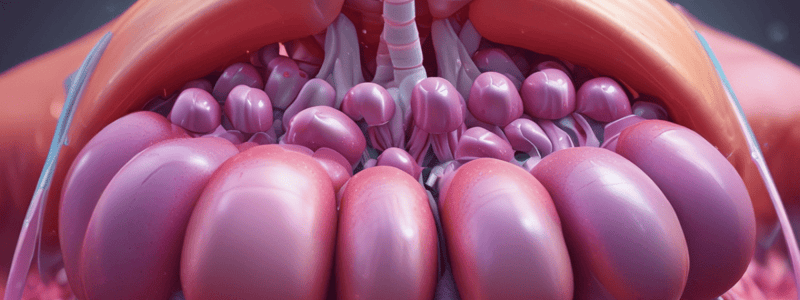Podcast
Questions and Answers
What is the key advantage of using diamorphine (heroin) for the management of dyspnoea in lung cancer patients?
What is the key advantage of using diamorphine (heroin) for the management of dyspnoea in lung cancer patients?
- Diamorphine has anxiolytic and antitussive effects that make it ideal for lung cancer. (correct)
- Diamorphine is less addictive than other opioids.
- Diamorphine has no risk of respiratory depression.
- Diamorphine is more effective than oral morphine for managing dyspnoea.
What is the recommended starting dose of oral morphine for a patient not already receiving morphine for dyspnoea?
What is the recommended starting dose of oral morphine for a patient not already receiving morphine for dyspnoea?
- 20 mg 4-hourly/prn
- 10 mg 4-hourly/prn
- 5 mg 4-hourly/prn (correct)
- 2.5 mg 4-hourly/prn
For patients already receiving morphine, either for pain or dyspnoea, what is the recommended increase in the overall dose?
For patients already receiving morphine, either for pain or dyspnoea, what is the recommended increase in the overall dose?
- 20% to 30%
- 50% to 70%
- 30% to 50% (correct)
- 10% to 20%
What is the recommended route of administration when the oral route is no longer available?
What is the recommended route of administration when the oral route is no longer available?
What is the primary reason for the use of benzodiazepines in the management of dyspnoea in palliative care?
What is the primary reason for the use of benzodiazepines in the management of dyspnoea in palliative care?
What is the main reason for not recommending the use of nebulized opiates for the management of dyspnoea?
What is the main reason for not recommending the use of nebulized opiates for the management of dyspnoea?
Why is intravenous or subcutaneous diamorphine often used for extreme dyspnoea and distress?
Why is intravenous or subcutaneous diamorphine often used for extreme dyspnoea and distress?
What is the key concern regarding the use of benzodiazepines for the management of dyspnoea in palliative care?
What is the key concern regarding the use of benzodiazepines for the management of dyspnoea in palliative care?
What is a symptom of underlying medical conditions affecting the airways?
What is a symptom of underlying medical conditions affecting the airways?
Which of the following is a preventive measure mentioned in the text for respiratory infections?
Which of the following is a preventive measure mentioned in the text for respiratory infections?
What is a pharmacological management approach mentioned in the text for respiratory issues?
What is a pharmacological management approach mentioned in the text for respiratory issues?
Which symptom is not commonly associated with haemoptysis as per the text?
Which symptom is not commonly associated with haemoptysis as per the text?
Which action is advised for the prevention of respiratory infections?
Which action is advised for the prevention of respiratory infections?
What is a non-pharmacological medical management approach for respiratory issues mentioned in the text?
What is a non-pharmacological medical management approach for respiratory issues mentioned in the text?
What is the recommended initial step for managing large-volume hemoptysis?
What is the recommended initial step for managing large-volume hemoptysis?
Which of the following is NOT mentioned as an endobronchial management option for visible central airway lesions?
Which of the following is NOT mentioned as an endobronchial management option for visible central airway lesions?
For which type of lesions is external beam radiotherapy recommended, according to the text?
For which type of lesions is external beam radiotherapy recommended, according to the text?
What is the medical term used to describe a nosebleed?
What is the medical term used to describe a nosebleed?
Which of the following is NOT listed as a potential cause of epistaxis in palliative care patients?
Which of the following is NOT listed as a potential cause of epistaxis in palliative care patients?
Which of the following is mentioned as a cause of epistaxis unrelated to palliative care?
Which of the following is mentioned as a cause of epistaxis unrelated to palliative care?
What is the recommended course of action if bronchoscopy and endobronchial management options are unsuccessful in managing hemoptysis?
What is the recommended course of action if bronchoscopy and endobronchial management options are unsuccessful in managing hemoptysis?
Which of the following is mentioned as a potential cause of epistaxis in the text?
Which of the following is mentioned as a potential cause of epistaxis in the text?
Which types of cancer are most commonly associated with cough in people with cancer?
Which types of cancer are most commonly associated with cough in people with cancer?
Which of the following medications is recommended for managing cough in palliative care patients?
Which of the following medications is recommended for managing cough in palliative care patients?
What is the most common cause of acute cough in people with cancer?
What is the most common cause of acute cough in people with cancer?
Which of the following statements about cough in palliative care patients is true?
Which of the following statements about cough in palliative care patients is true?
Which of the following statements about the severity of cough in palliative care patients is true?
Which of the following statements about the severity of cough in palliative care patients is true?
Which of the following is NOT mentioned as a potential cause of cough in palliative care patients?
Which of the following is NOT mentioned as a potential cause of cough in palliative care patients?
Which of the following statements about smoking cessation in palliative care patients is true?
Which of the following statements about smoking cessation in palliative care patients is true?
Which of the following statements about cough in palliative care patients is NOT true?
Which of the following statements about cough in palliative care patients is NOT true?
What is the first step patients at increased risk of epistaxis are advised to take in first aid management?
What is the first step patients at increased risk of epistaxis are advised to take in first aid management?
Why should patients avoid lying down or tilting their heads back during a nosebleed?
Why should patients avoid lying down or tilting their heads back during a nosebleed?
Which medication is NOT recommended for patients as part of medical treatment for epistaxis?
Which medication is NOT recommended for patients as part of medical treatment for epistaxis?
What is the purpose of using a saline nasal spray or drops as part of health education to prevent epistaxis?
What is the purpose of using a saline nasal spray or drops as part of health education to prevent epistaxis?
In first aid management of epistaxis, where should firm pressure be applied when pinching the nose?
In first aid management of epistaxis, where should firm pressure be applied when pinching the nose?
Which action should patients avoid after their nosebleed has stopped?
Which action should patients avoid after their nosebleed has stopped?
What is one reason given in the text for avoiding aspirin and NSAIDs in patients with epistaxis?
What is one reason given in the text for avoiding aspirin and NSAIDs in patients with epistaxis?
Why is adequate pain control in patients with posterior nasal packing a concern?
Why is adequate pain control in patients with posterior nasal packing a concern?
Flashcards are hidden until you start studying




